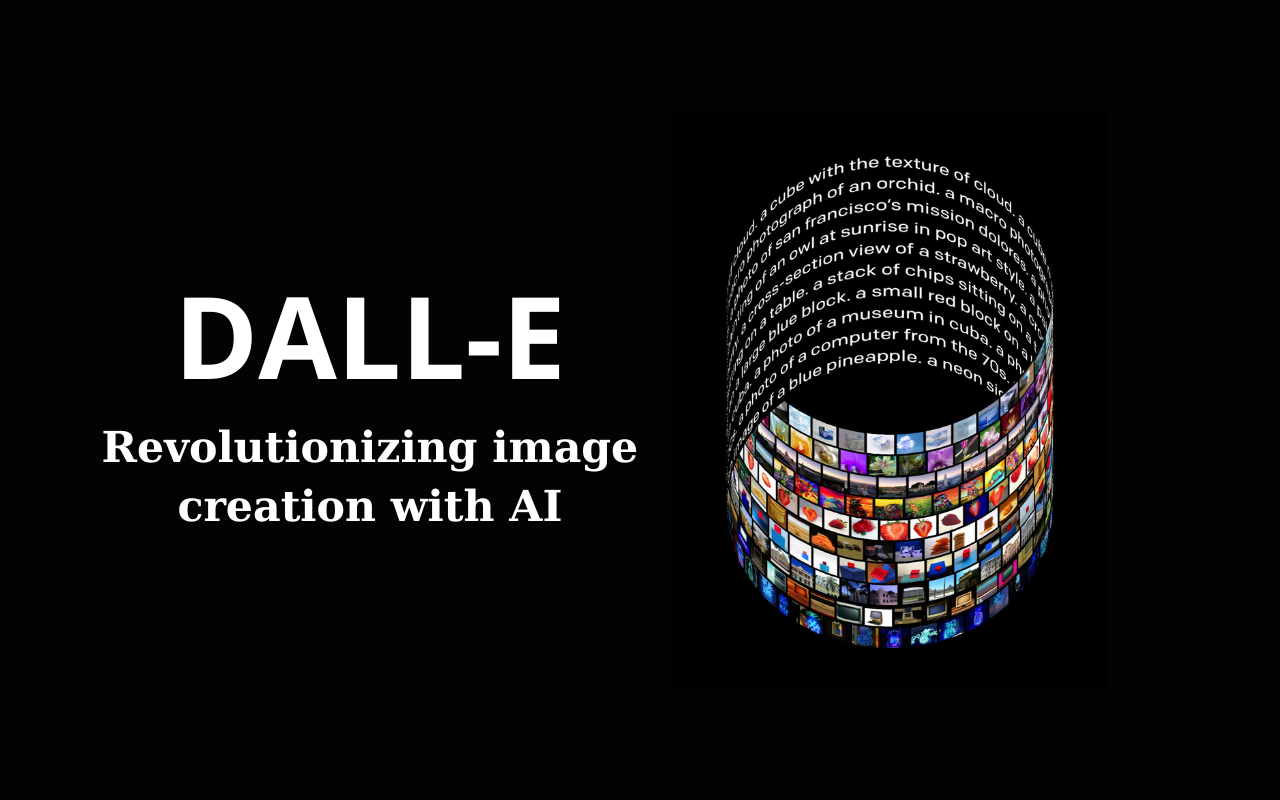AI image generation has completely transformed over the past few years. What used to be a niche technology restricted to big tech companies is now accessible to anyone with an internet connection, thanks to new deep learning models like DALL-E.
In this post, I’ll give you a breakdown of the DALL-E model – what it is, how it works, and some of the mind-blowing images it can create. We’ll also discuss the implications of this technology and how it might impact stock photography, digital art, and more.
Let’s get started!
What is DALL-E?

DALL-E is an AI system created by OpenAI that can generate realistic images and art from a text description.
The name is inspired by the iconic Spanish surrealist artist Salvador Dali and Pixar’s friendly robot WALL-E. Put them together and you get DALL-E!
Some examples of text prompts and images created by DALL-E include:
- An armchair in the shape of an avocado -> A photo-realistic rendered image of said armchair
- A daisy made of rubies -> A daisy with petals made of shining red gemstones
- A baby peregrine falcon wearing a tiny knitted scarf -> An adorable falcon hatchling wearing a scarf
As you can see, DALL-E has a very good imagination!
The key thing that enables DALL-E to generate these inventive images is neural networks.
How DALL-E Leverages Neural Networks
DALL-E uses a type of deep learning called a transformer neural network.
The model is trained on billions of image-text pairs from the internet to establish connections between textual concepts and visual elements.
For example, by looking at millions of captioned images online, the AI understands that a photo with the text “pet dog” likely contains an image of a furry canine animal.
When given a new text prompt, DALL-E scans its vast mental database to extract relevant visual components that best match the description. It then creatively combines and renders these elements into an entirely novel image generated just for that prompt!
This enables the AI system to not just re-mix existing images but to autonomously imagine and create images that are completely new.
But generating convincing images requires more than just extracting concepts – the images also have to look realistic.
That’s where diffusion models come in…
Diffusion Models for Realistic Image Generation
Traditional neural networks would struggle to render realistic textures and coherent images.
DALL-E gets around this through diffusion models. This is a cutting-edge technique in AI that involves ‘diffusing’ or randomizing noise into an image thousands of times until a recognizable image emerges from the chaos!
By fine-tuning this diffusion process, the AI learns how to introduce noise in smarter ways so that the final output looks crisp, clear, and strikingly realistic.
This allows DALL-E to produce images with fine details that accurately depict materials, lighting, shadows, and colors that are surprisingly convincing to human viewers.
Combining the imaginative capacities of transformers with the realism of diffusion models is what gives DALL-E its unique creative flair.
Let’s see some examples!
What Kind of Images Can DALL-E Generate?
We’ve already seen that DALL-E can render unusual concepts like an avocado armchair or gemstone flower. But what are the practical uses of AI image generation?
Well, since DALL-E has been trained on a huge cultural dataset, it can visualize a vast range of topics spanning different eras, genres, and mediums.
Some examples include:
- Illustrations – original digital artwork depicting fantastical scenes
- Infographics – visually explaining concepts with charts, maps, timelines
- Retouched photos – intelligently enhancing images like removing objects or aging faces
- Photography – posing products, people, or animals in creative photo shoots
- Advertisements – mock ads for products that don’t exist yet
- Landscapes – worlds that only exist in fiction or your imagination
- Fashion – outfit and clothing designs modeled on mannequins
- Architecture – intricate 3D renderings of buildings real or dreamed up
And those are just a few categories! DALL-E has generated over 2 million images and counting for over 200,000 users.
The possibilities seem endless. As one DALL-E user quipped: “It’s like having a million Picassos in your computer!“
But how do these AI-generated images compare to what humans can create?
Can AI Art Compare to Human Creativity?
There’s no doubt AI systems like DALL-E display an impressive degree of creativity and imagination.
The technology provokes many philosophical questions – what is creativity? Can machines be truly creative? What defines art?
Those are complex issues with no easy answers.
Practically speaking, AI-generated images often mimic and remix elements found in its training data rather than profoundly revolutionizing entire paradigms of visual culture.
So there are limitations to machine originality and vision. That’s why many believe human artists still reign supreme when it comes to showing groundbreaking creativity, expressing rich emotions, and pioneering completely novel styles.
However, just because an image came from DALL-E doesn’t make it any less amazing or thought-provoking! AI art stands as an incredible technical and cultural achievement.
And artist or not, DALL-E allows anyone to tap into radical creativity – converting your wildest imagination into tangible images with ease.
That kind of creative accessibility will have huge implications across many visual fields and industries.
The Impact of AI Image Generation
Tools like DALL-E foreshadow how AI could transform jobs that deal with photography, digital art, graphic design, and more.
Some applications include:
- Empowering Individual Creativity – anyone can create graphics, scenes, and posters without technical artistic skill
- Assisting Working Creative Professionals – AI can rapidly provide initial concepts/drafts to build on
- Automating & Scaling Content Creation – DALL-E massively amplifies the output of visual media
- Provoking Innovation In Established Media – exploring new avenues like AI/human collaborations
- Enabling New Forms of Generative Art – using AI to manifest imaginative interior worlds
- Raising Legal Questions Around Copyright & Ownership – who owns an AI-generated image? Can AI develop its own creative IP?
These are all active discussions among artists and creative industries grappling with this technology.
While there are certainly open questions, I’m excited to see how AI image generation spurs more creativity, not less!
Just think what we might envision if unshackled by technical constraints. Or how creatives might incorporate this tech into their inventories.
And for the everyday person, being able to create anything you imagine could make digital art more fulfilling and meaningful!
I don’t know about you, but my mind is bursting with ideas to try out now. This prompts me to my next point…
How You Can Access DALL-E Today
In the past, advanced AI systems were locked away in research labs reserved for computer science PhDs.
But thanks to OpenAI’s mission towards safe and responsible AI development, DALL-E is now available in a public beta for aspiring everyday creators!
To sign up for DALL-E access:
- Go to OpenAI’s DALL-E waitlist page
- Enter your email for the waitlist
- Wait for an invite to create an OpenAI account!
Once you gain access, you’ll have a starting credit balance to generate images with DALL-E. There may even be options for certain users to earn additional free credits.
Try out wacky, wonderful, or even mundane ideas – realize your creative visions faster than ever thanks to AI!
Just take care not to violate OpenAI’s content policy, which prohibits violent, illegal, or misleading imagery.
So get excited and sign up today to start manifesting your visual imagination with this revolutionary tech!
And there you have it – a comprehensive look at OpenAI’s game-changing DALL-E model for AI image generation.
We covered how DALL-E leverages neural networks and diffusion models to generate shockingly realistic and creative images.
This technology showcases AI’s imaginative capacities while complementing uniquely human strengths like emotional expression and pioneering innovation.
DALL-E promises to empower individual creativity, assist professional artists, automate content production, and provoke new forms of generative art.
So sign up and try DALL-E today to see your visual imagination brought to life!
Let me know what radical, hilarious, or downright strange images you cook up with this futuristic tech. I can’t wait to see what the imagination of ChatGPT comes up with!
